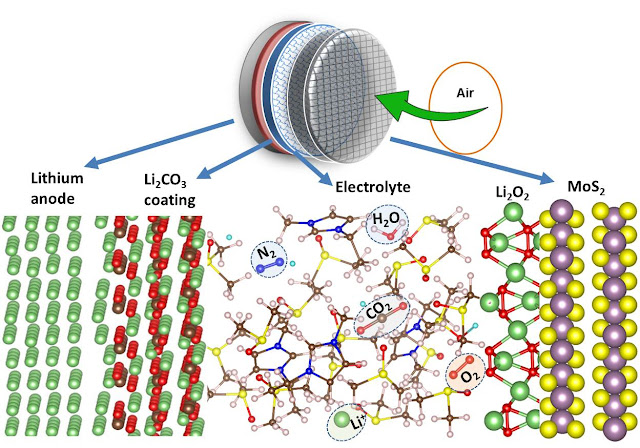The lithium–air battery (Li–air) is a metal–air electrochemical cell or battery chemistry the uses oxidation of lithium at
the anode and reduction of oxygen at
the cathode to
induce a current flow. Pairing lithium and ambient oxygen can theoretically
lead to electrochemical cells with the highest possible specific
energy. Indeed, the theoretical specific energy of a non-aqueous
Li–air battery, in the charged state with Li2O2 product
and excluding the oxygen masks, is ~40.1 MJ/kg. This is comparable to the
theoretical specific energy of gasoline, ~46.8 MJ/kg. In practice, Li–air
batteries with a specific energy of ~6.12 MJ/kg at the cell level have been
demonstrated. This is about 5 times greater than that of a commercial lithium-ion battery, and is sufficient to run a
2,000 kg EV for ~500 km (310 miles) on one
charge using 60 kg of batteries.
However, the practical power and life-cycle of Li–air batteries need significant improvements before they can find a market niche. Significant electrolyte advances are needed to develop a commercial implementation. Four approaches are active: aprotic, aqueous, solid state and mixed aqueous–aprotic. Metal–air batteries, specifically zinc–air, have received attention due to potentially high energy densities. The theoretical specific energy densities for metal–air batteries are higher than for ion-based methods. Lithium–air batteries can theoretically achieve 3840 mA·h/g.
A major market
driver for batteries is the automotive sector. The energy density of gasoline
is approximately 13 Kw h/kg, which corresponds to 1.7 kW·h/kg of
energy provided to the wheels after losses. Theoretically, lithium–air can
achieve 12 kW·h/kg (43.2 MJ/kg) excluding the oxygen mass. Accounting
for the weight of the full battery pack (casing, air channels, lithium
substrate), while lithium alone is very light, the energy density is
considerably lower. A Li–air battery potentially had 5–15 times the specific
energy of a Li-ion battery.




I was very pleased to find this site.I wanted to thank you for this great read!! I definitely enjoying every little bit of it and I have you bookmarked to check out new stuff you post adsorbent manufacturers
ReplyDelete